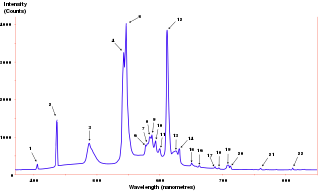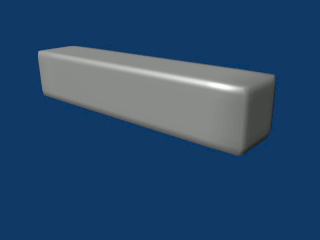
An equal temperament is a musical temperament or tuning system that approximates just intervals by dividing an octave into steps such that the ratio of the frequencies of any adjacent pair of notes is the same. This system yields pitch steps perceived as equal in size, due to the logarithmic changes in pitch frequency.

Frequency, most often measured in hertz, is the number of occurrences of a repeating event per unit of time. It is also occasionally referred to as temporal frequency for clarity and to distinguish it from spatial frequency. Ordinary frequency is related to angular frequency by a factor of 2π. The period is the interval of time between events, so the period is the reciprocal of the frequency: T = 1/f.
In music, notes are distinct and isolatable sounds that act as the most basic building blocks for nearly all of music. This discretization facilitates performance, comprehension, and analysis. Notes may be visually communicated by writing them in musical notation.

Pink noise, 1⁄f noise, fractional noise or fractal noise is a signal or process with a frequency spectrum such that the power spectral density is inversely proportional to the frequency of the signal. In pink noise, each octave interval carries an equal amount of noise energy.

The sawtooth wave is a kind of non-sinusoidal waveform. It is so named based on its resemblance to the teeth of a plain-toothed saw with a zero rake angle. A single sawtooth, or an intermittently triggered sawtooth, is called a ramp waveform.

Pitch is a perceptual property that allows sounds to be ordered on a frequency-related scale, or more commonly, pitch is the quality that makes it possible to judge sounds as "higher" and "lower" in the sense associated with musical melodies. Pitch is a major auditory attribute of musical tones, along with duration, loudness, and timbre.

In signal processing and related disciplines, aliasing is the overlapping of frequency components resulting from a sample rate below the Nyquist rate. This overlap results in distortion or artifacts when the signal is reconstructed from samples which causes the reconstructed signal to differ from the original continuous signal. Aliasing that occurs in signals sampled in time, for instance in digital audio or the stroboscopic effect, is referred to as temporal aliasing. Aliasing in spatially sampled signals is referred to as spatial aliasing.

Johnson–Nyquist noise is the electronic noise generated by the thermal agitation of the charge carriers inside an electrical conductor at equilibrium, which happens regardless of any applied voltage. Thermal noise is present in all electrical circuits, and in sensitive electronic equipment can drown out weak signals, and can be the limiting factor on sensitivity of electrical measuring instruments. Thermal noise is proportional to absolute temperature, so some sensitive electronic equipment such as radio telescope receivers are cooled to cryogenic temperatures to improve their signal-to-noise ratio. The generic, statistical physical derivation of this noise is called the fluctuation-dissipation theorem, where generalized impedance or generalized susceptibility is used to characterize the medium.

In signal processing, the power spectrum of a continuous time signal describes the distribution of power into frequency components composing that signal. According to Fourier analysis, any physical signal can be decomposed into a number of discrete frequencies, or a spectrum of frequencies over a continuous range. The statistical average of any sort of signal as analyzed in terms of its frequency content, is called its spectrum.
A busy signal in telephony is an audible call-progress tone or audible signal to the calling party that indicates failure to complete the requested connection of that particular telephone call.
The sensitivity of an electronic device, such as a communications system receiver, or detection device, such as a PIN diode, is the minimum magnitude of input signal required to produce a specified output signal having a specified signal-to-noise ratio, or other specified criteria. In general, it is the signal level required for a particular quality of received information.

Intermodulation (IM) or intermodulation distortion (IMD) is the amplitude modulation of signals containing two or more different frequencies, caused by nonlinearities or time variance in a system. The intermodulation between frequency components will form additional components at frequencies that are not just at harmonic frequencies of either, like harmonic distortion, but also at the sum and difference frequencies of the original frequencies and at sums and differences of multiples of those frequencies.
This is a list of the fundamental frequencies in hertz (cycles per second) of the keys of a modern 88-key standard or 108-key extended piano in twelve-tone equal temperament, with the 49th key, the fifth A (called A4), tuned to 440 Hz (referred to as A440). Every octave is made of twelve steps called semitones. A jump from the lowest semitone to the highest semitone in one octave doubles the frequency (for example, the fifth A is 440 Hz and the sixth A is 880 Hz). The frequency of a pitch is derived by multiplying (ascending) or dividing (descending) the frequency of the previous pitch by the twelfth root of two (approximately 1.059463). For example, to get the frequency one semitone up from A4 (A♯4), multiply 440 Hz by the twelfth root of two. To go from A4 up two semitones (one whole tone) to B4, multiply 440 twice by the twelfth root of two (or once by the sixth root of two, approximately 1.122462). To go from A4 up three semitones to C5 (a minor third), multiply 440 Hz three times by the twelfth root of two (or once by the fourth root of two, approximately 1.189207). For other tuning schemes, refer to musical tuning.

In audio engineering, electronics, physics, and many other fields, the color of noise or noise spectrum refers to the power spectrum of a noise signal. Different colors of noise have significantly different properties. For example, as audio signals they will sound different to human ears, and as images they will have a visibly different texture. Therefore, each application typically requires noise of a specific color. This sense of 'color' for noise signals is similar to the concept of timbre in music.

In the field of solid mechanics, torsion is the twisting of an object due to an applied torque. Torsion is expressed in either the pascal (Pa), an SI unit for newtons per square metre, or in pounds per square inch (psi) while torque is expressed in newton metres (N·m) or foot-pound force (ft·lbf). In sections perpendicular to the torque axis, the resultant shear stress in this section is perpendicular to the radius.
The precise tone plan is a signaling specification for the public switched telephone network (PSTN) in North America. It defines the call-progress tones used for indicating the status and progress of telephone calls to subscribers and operators.
Ringing tone is a signaling tone in telecommunication that is heard by the originator of a telephone call while the destination terminal is alerting the receiving party. The tone is typically a repeated cadence similar to a traditional power ringing signal (ringtone), but is usually not played synchronously. Various telecommunication groups, such as the Bell System and the General Post Office (GPO) developed standards, in part taken over by the European Telecommunications Standards Institute (ETSI) and other standards bodies. With modern cell phone and smartphone technology ringing tone can be customized and even used for advertising.
MIDI Tuning Standard (MTS) is a specification of precise musical pitch agreed to by the MIDI Manufacturers Association in the MIDI protocol. MTS allows for both a bulk tuning dump message, giving a tuning for each of 128 notes, and a tuning message for individual notes as they are played.
The Second-order intercept point, also known as the SOI, IP2, or IIP2, is a measure of linearity that quantifies the second-order distortion generated by nonlinear systems and devices. Examples of frequently used devices that are concerned with this measure are amplifiers and mixers. It is related to the third-order intercept point, which is generally used for quantifying degree of nonlinearity of a nonlinear system or it can also be used to estimate the nonlinear products present at the output of such a system.

In physics, sound is a vibration that propagates as an acoustic wave through a transmission medium such as a gas, liquid or solid. In human physiology and psychology, sound is the reception of such waves and their perception by the brain. Only acoustic waves that have frequencies lying between about 20 Hz and 20 kHz, the audio frequency range, elicit an auditory percept in humans. In air at atmospheric pressure, these represent sound waves with wavelengths of 17 meters (56 ft) to 1.7 centimeters (0.67 in). Sound waves above 20 kHz are known as ultrasound and are not audible to humans. Sound waves below 20 Hz are known as infrasound. Different animal species have varying hearing ranges.


























